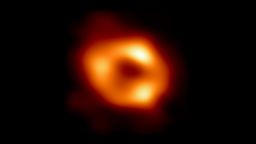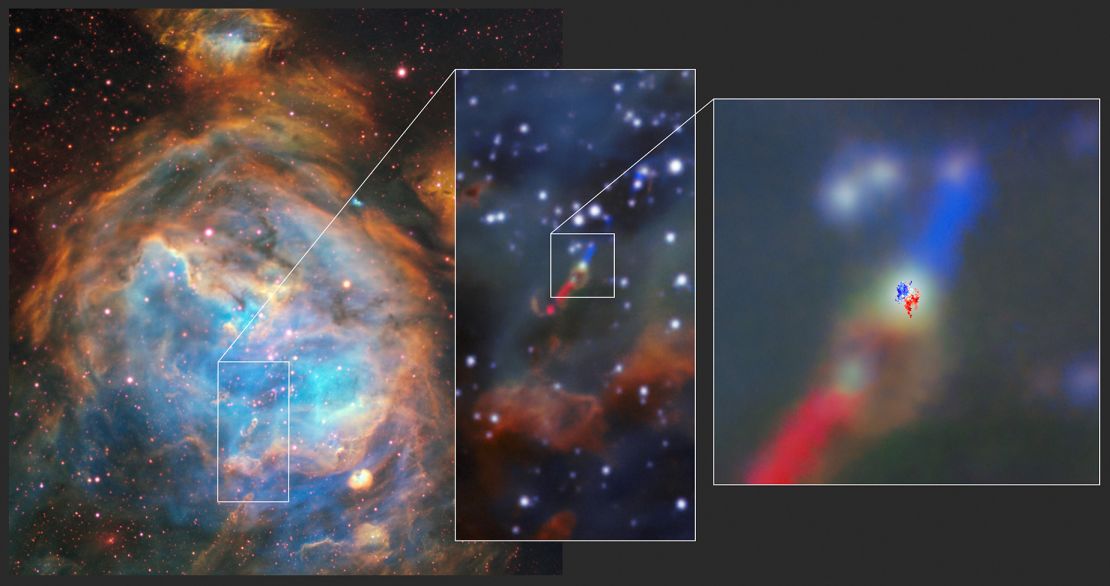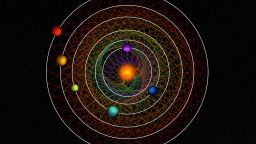Unprecedented Discovery: Young Star with Planetary Disc in Large Magellanic Cloud
Planet-forming disk: First time ever, astronomers have observed a young star in of the Milky Way galaxy that’s ringed by a dense disc where planets could be formed.
Star and Planet Development Insights: A New Perspective on Accretion Discs
A massive star named HH 1177, as well as its spinning disk were observed inside the Large Magellanic Cloud nearby dwarf galaxy which is located around 160,000 light years away. This discovery is unprecedented and can help scientists gain greater understanding of the process of star and planet development.
A new star expands in size due to the pull of particles from the surrounding. Dust and gas accumulate within a flat disc around the star, referred to as an accretion disc, because of powerful gravitational forces. The spinning disk moves particles onto the star which becomes larger. The bigger the mass of the star, the greater its gravitational field gets and it draws more dust and gas in the disc.

The black hole in our galaxy is spinning fast and drags space-time along with it, according to scientists.
Distinctive Characteristics: HH 1177’s Rapid Development and Unique Galactic Setting: Planet-forming disk
A massive star like HH 1177 has a fast life span and is young, developing faster and with a the lifespan of less than that of a star such as our sun. The shorter timeline makes the beginning phases of massive stars difficult to see within our galaxy, since both the disk and the star is obscured by the dusty matter from which it develops.
However, the substance from which stars form inside the Large Magellanic Cloud is different from the Milky Way.
The HH 1177 constellation is in the nursery of stars, also known as N180 which has lower dust and a lower abundance of metals. The star is not hidden by a cocoon of dust and gas which gives a distant, however clear views.
“When I first saw evidence for a rotating structure in the ALMA data I could not believe that we had detected the first extragalactic accretion disc, it was a special moment,” said the lead author of the study Professor. Anna McLeod, an associate professor of Physics in Durham University in the United Kingdom in an announcement. “We know discs are vital to forming stars and planets in our galaxy, and here, for the first time, we’re seeing direct evidence for this in another galaxy.”
Astronomers made the detection of the star, which is estimated to be about 15 times the mass of our sun, using the Atacama Large Millimeter/submillimeter Array of telescopes in Chile, known as ALMA. The results were released on this week within the Nature journal. Nature.
Extragalactic Marvel: First Detection of an Extragalactic Accretion Disc
The ALMA observations were made as an extension of the previous observation made by the Southern Observatory of Europe’s Very Large Telescope. This telescope, called the Multi Unit Spectroscopic Explorer, also known as the MUSE instrument, which is located on the telescope, captured a stream of matter escaping from the star’s young. HH 1177 was discovered deep in a gas cloud within the galaxy.
“We discovered a jet being launched from this young massive star, and its presence is a signpost for ongoing disc accretion,” McLeod declared.

Multiple observatories played a role in discovering the existence of an extragalactic disc. Jets from the Star were initially observed by ALMA’s Very Large Telescope’s MUSE instruments (left and right). Surveys taken by ALMA (right) showed the rotating disk surrounding the star.ESO/ALMA (ESO/NAOJ/NRAO)/A. McLeod et al.
To determine if there was a disk around it, scientists had to determine how fast dense gas circulated about the stars.
When matter is drawn towards the young and evolving star, it does not drop directly intoonto an object of celestial origin. Instead, the material becomes flat and rotates around the star and creates an elongated disk. The disk is faster to rotate at its center. This difference may aid astronomers in determining the existence of a disk around the star.
Technological Advancements and Exciting Prospects: A New Era in Astronomical Research : Planet-forming disk

Astronomers have discovered a rhythmic family of exoplanets that includes six
“The frequency of light changes depending on how fast the gas emitting the light is moving towards or away from us,” explained co-author of the study Dr. Jonathan Henshaw, a research associate at the University of Liverpool in the UK. Liverpool John Moores University, in a statement “This is precisely the same phenomenon that occurs when the pitch of an ambulance siren changes as it passes you and the frequency of the sound goes from higher to lower.”
The ALMA observations allowed ALMA to provide precise measurements of the spin of the disk.
Young stars aren’t the only celestial phenomenon that have accretion disks. Supermassive black holes also possess thin glowing disks spinning around them, which can feed on.
“We are in an era of rapid technological advancement when it comes to astronomical facilities,” McLeod declared. “Being able to study how stars form at such incredible distances and in a different galaxy is very exciting.”
Planet-forming disk Planet-forming disk Planet-forming disk Planet-forming disk Planet-forming disk Planet-forming disk
